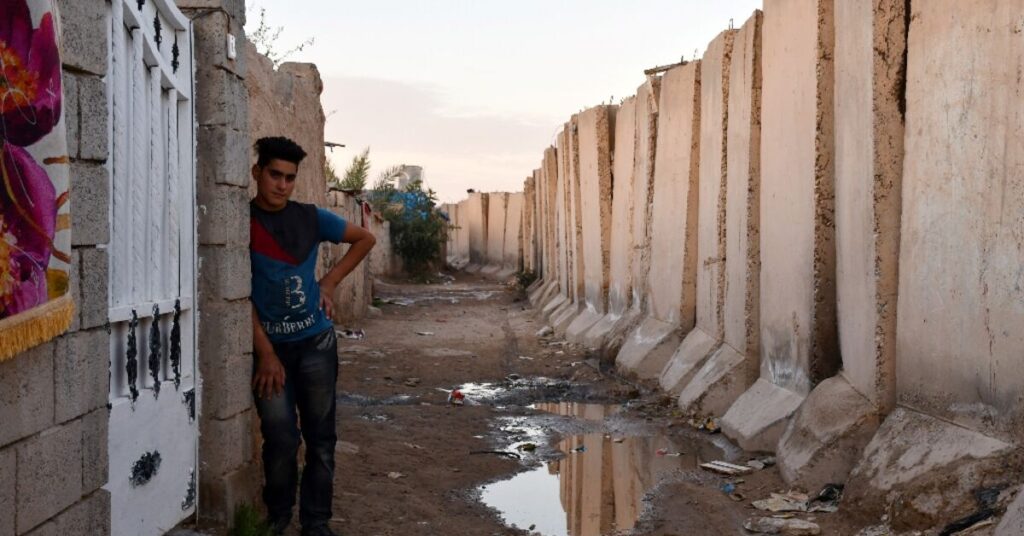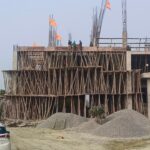Khaled Ibrahim goals of a home on the outskirts of Samarra, however a concrete wall constructed to guard the Iraqi metropolis is holding him again and hindering much-needed city growth.
The wall, which was constructed greater than a decade in the past on the peak of Iraq’s civil conflict that tore the multi-faith, multi-ethnic nation aside, says the wall should stay standing to forestall the specter of jihadist violence whilst safety has regularly improved throughout the nation.
Samarra is residence to the Al-Askari Shrine, certainly one of Shia Islam’s holiest websites and well-known for its golden dome, however is situated within the predominantly Sunni province of Salahaddin.
An assault by the Sunni militant group Al-Qaeda in 2006 destroyed the dome, sparking a brutal sectarian battle that killed tens of hundreds of individuals. A yr later, a second assault destroyed the 2 minarets on the website.
At this time, the wall round Samarra has additionally change into a burden on each day life within the metropolis, which has expanded from 300,000 to 400,000 inhabitants since 2008, growing actual property and land prices.
“It is a nightmare, worse than a jail,” Ibrahim mentioned.
The 52-year-old and his two sons, who all work as day laborers, at present hire lodging in Samarra for about $180 a month, which is a small fortune for them.
Ibrahim has a plot of land simply exterior town partitions the place he want to construct a home, however he’s turning into more and more annoyed that the fortified barrier makes this unattainable.
“The safety forces should not permitting us to strategy the wall,” he mentioned.
“After which there are not any amenities, no water, no electrical energy. Constructing exterior the wall is like dwelling in exile.”
Within the Iraqi capital Baghdad, 110 kilometers (70 miles) to the south, lots of the blast partitions that when surrounded key streets, embassies and authorities buildings are being demolished.
However in Samarra, small, unfinished concrete block homes are left to languish simply inside town wall. On the opposite aspect, deserted plots stretch so far as the attention can see.
– ‘Sleep cells’ stay a risk –
There are three tightly managed checkpoints within the obstacles that enable entry to Samarra, residence to the stays of what was the capital of the Abassid Caliphate within the ninth century and is now a UNESCO World Heritage Web site.
Authorities are conscious of residents’ frustrations and plan to renovate the wall, with work beginning inside a month.
They plan to develop the perimeter by three to seven kilometers, improve the variety of entry factors to 6 and add watchtowers and surveillance cameras.
“We’d have appreciated to take away it, however there are obligations and safety plans that require its presence,” Riyad al-Tayyas, Salahaddin’s deputy governor, informed AFP.
Tayyas mentioned development exterior the wall was not formally prohibited, however he acknowledged that the barrier’s presence hindered city growth.
Residents are selecting to not construct on the opposite aspect, fearing they are going to be “reduce off from the remainder of town,” Tayyas mentioned.
Nonetheless, he insisted that ongoing safety issues meant the barrier ought to stay in place.
That is to make sure that there isn’t any “repeat of the 2006 disaster, which led to a sectarian conflict”, he informed AFP.
“Although the safety state of affairs has improved, there are nonetheless sleeper cells” of the Islamic State group (IS), he mentioned.
A 2023 UN report famous a decline within the frequency of IS assaults in city facilities, but in addition warned that the group has maintained a presence in its strongholds, together with round Salahaddin.
Tayyas’ place echoes the issues of some Samarra residents, corresponding to 64-year-old retiree Laith Ibrahim, who mentioned he was in favor of increasing the perimeter of the wall.
“In Samarra, inside the metropolis, the safety state of affairs is great. It is clear exterior,” he mentioned.
However there’s additionally “a scarcity of land and housing,” he mentioned. “Actual property (costs) are rising daily.”


